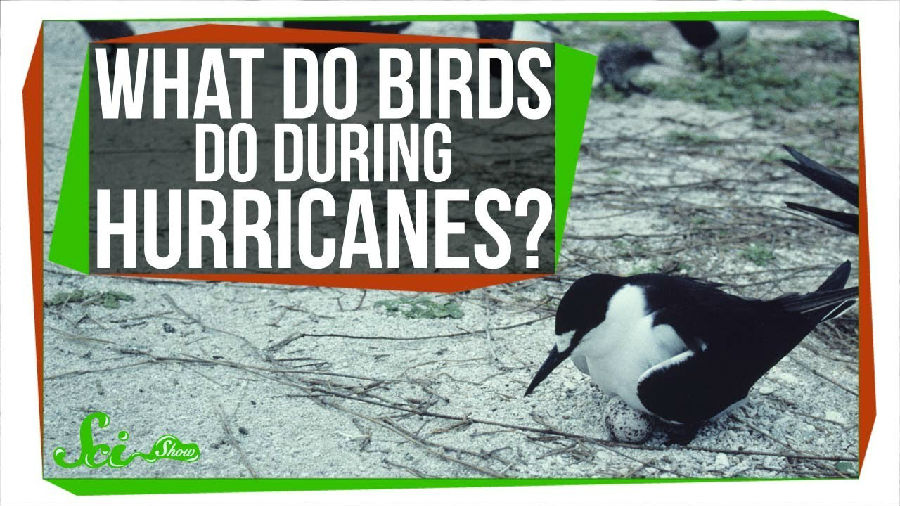The 2017 hurricane season sure packed a wallop.
2017年飓风季节有巨大力量。
Three major storms -- Harvey, Irma, and Maria -- decimated the Caribbean and the southern US.
三场主要风暴—哈维、厄玛以及玛丽亚—席卷加勒比海以及美国南部。
While the focus has rightfully been on the impacts to those living in the storm's path, you might wonder how other creatures fared.
按理飓风对沿途生物有着影响,你或许想知道其他生物是怎么活过来的。
Some species seem to be able to sense the impending danger and flee.
一些物种似乎能够感知迫在眉睫的危险并逃走。
Landlubbers like us that don't get out of the way just have to hunker down as best they can.
像我们这些毫无经验的人还是不要挡路啦,最好保持低调。
But birds and other airborne animals sometimes do what sounds like the worst idea ever: they ride things out in the eye of the storm.
但是鸟类和其他会飞的动物有时会做出似乎最糟糕的主意:它们经受得住飓风的中心。
Meteorologists have witnessed this thanks to something called dual-polarization or dual-pol radar,
多亏了被称为双偏振或双极化雷达的东西,气象学家亲眼目睹了这一画面,
which uses pulses of electromagnetic waves to detect the size and shape of objects in two dimensions.
双偏振或双极化雷达利用电磁波的脉冲探测二维空间物体的大小和形状。
Based on the pattern of the waves, they can see the proportions of whatever's in the storm — including birds and insects,
基于波形模式,他们能够看到风暴中任何物体的比例—包括突出的鸟类和昆虫,
which stand out because they're much less spherical than, say, a raindrop.
因为它们不像雨滴是球形的。
And when meteorologists map out what they've detected with radar, they often find a bunch of animals inside the eyes of big storms.
并且当气象学家在地图标出用雷达探测到的物体时,他们通常发现在大风暴中心有一堆动物。
Heading into a hurricane for safety sounds pretty bold … and ill-advised.
为安全起见,它们全都朝着飓风走去,这听起来相当大胆且轻率。
But within the eye, the weather is calm.
但在暴风中心,天气却很平静。
It's a spot of extremely low pressure, which helps drive the overall storm, but isn't very windy itself.
少量极端低压能够帮助推动暴风,但它本身却是少风的。
It doesn't even have clouds, since the air in the eye is about 5 degrees warmer than the rest of the storm, and it can hold more water before condensing.
里边甚至没有云,因为中心空气比暴风其他地方高5度,它能够在压缩前储存更多水分。
So, all things considered, it's relatively safe for birds and bugs.
所以从整体来看,中心对于鸟类和小虫而言相对安全。
Not that it's an intentional strategy on their part—they probably don't plan this out.
并不是说这是动物们的意向战略—它们不可能做出这种计划。

Either the eye forms around them, or they just happen to find the eye and then end up kinda stuck there.
要么是暴风中心就在它们附近,要么是它们恰好发现这个中心,然后困在那里了。
This especially happens with seabirds.
海鸟就是这样。
The real danger is running into the eyewall, the vertical wall of clouds that surrounds the eye, which is the most intense part of the storm.
跑进风眼墙真正的危险之处在于,围绕在中心的云层直墙,这是暴风最强烈的部分。
It has the heaviest rainfall and strongest winds.
这里有着最大的降雨量以及最强劲的风。
Sticking to the eye can work, but it can be tough to make it through if a hurricane is especially long-lived.
粘着暴风中心能起到作用,要渡过难关很困难,如果飓风历时非常长的话。
Trapped birds don't have much choice but to keep flapping—they can't really stop to sleep or eat—so this kind of travel can wear them out.
被困的鸟类除了跟着飞行别无他法—它们不能停下、睡觉或觅食—所以这种旅途会让它们精疲力竭。
Sometimes they die.
有时会死掉。
And since, you know, a hurricane swept through their habitat, there may not be much left to come home to.
所以既然飓风席卷它们的栖息地,家里没不剩下什么了。
Or, if they're migratory birds, they can be blown hundreds of kilometers off course.
或者如果它们是候鸟,它们会被被吹到几百米远而偏离轨道。
In 2005, Hurricane Wilma deposited a flock of North American chimney swifts in Western Europe.
2005年,飓风威尔玛将一群北美洲产燕子搁浅到了西欧。
More than 700 of the birds died, and ornithologists found that the following year, the total population had been cut in half.
七百多只鸟死亡,鸟类学家发现接下来一年,该鸟类总量减少了一半。
It can be hard to collect good data on what happens to birds during and after a storm, as each hurricane is different.
对飓风期间和飓风之后,鸟类所经历的一切,很难收集到好的数据,因为每个飓风都不同。
But birdwatchers can help with that.
但观鸟者能够有所帮助。
Safety first, obviously, but if you ever see "hurricane birds"—species well outside of their usual homes during or after a storm
当然安全第一,但如果看到“飓风鸟”——那些暴风后中后期被吹离家园的种类
you can report your observations so scientists can learn more about how animals deal with tropical cyclones.
你可以将你观察到的上报,这样科学家就能了解这些动物是如何应对热带气旋的。
It's one of the more unusual types of citizen science.
这是全民科学不常见类型之一。
Thanks for asking, and thanks as always to all our patrons on Patreon. Your support helps us weather any storm.
感谢提问,感谢Patreon的赞助人。你们的支持帮助我们度过难关。
If you want to help us make more episodes like this, you can go to patreon.com/scishow.
如果你想帮助我们录制更多科学秀,请登录patreon.com/scishow。












